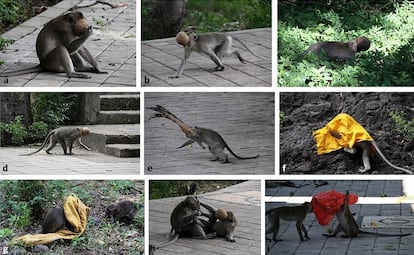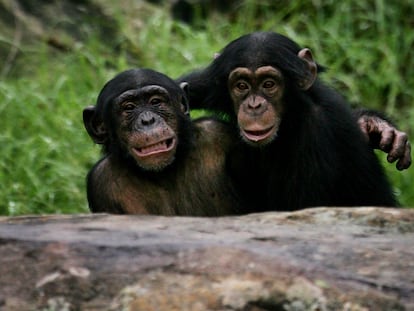From blind man’s bluff to primates hiding behind coconuts, when it comes to animals the act of play is training for the unexpected
Self-limiting games serve an important evolutionary function, according to different studies on primates, deer, whales and rats

The game begins. One participant, the “little chicken,” covers their eyes with a scarf and the rest form a circle around them, holding hands. When the ring of players is ready, they begin to ask, “Little chicken, what have you lost?” to which the person in the center responds, “a needles and a thimble.” The other players begin to rotate, chanting “turn three times and you’ll find it.” From there, the little chicken attempts to trap someone and when they do, figure out their identity through touch alone. If they get it right, the roles are exchanged.
Spain’s gallinita ciega, or blind little chicken, has been played in one form or another, around the world, for centuries. In English-speaking countries, they call it blind man’s bluff, in Bangladesh, kanamachi and in Nigeria, kola onye tara gi okpo. It’s been depicted in countless illustrations, as in one from a 13th-century manuscript owned by the Atger Museum in Montpellier, in a 1560 work by Pieter Brueghel the Elder named Children’s Games, in a 1912 Chinese schoolbook and on one of the pieces painted by Goya in 1789 to decorate the bedroom of the young inhabitants of the El Prado palace.
Covering one’s eyes to play is so universal that even other primates do it. Alyse Cunningham was the first to document this behavior in 1921. She was the caretaker of John Daniell, a lowland gorilla who as a baby was captured by French agents in Gabon. Cunningham described how one of the gorilla’s favorite games was to close his eyes tightly and run around, smacking into the household furniture.
Since then, the behavior has been documented in all large primates. Barbara Harrison, a pioneer in orangutan conservation, described in 1962 how two young males had a sort of diaper duel: one covered his face and eyes with a diaper and the other ran to tear it off, returning his companion’s sight. When the second male managed the task, they changed roles and started anew.
Monkeys also play the game. A recent study documented how, in the areas surrounding Bali’s Pura Pulaki temple, macaques (Macaca fascicularis) make a habit of using pieces of empty coconuts to cover their eyes while playing. The behavior has been noted in a good percentage of the group’s individuals, from adults to juveniles.

The study’s authors offer an explanation for this play, saying that it may have begun by chance. Let’s imagine that a macaque is using its hands and teeth to get at the white edible center of a coconut. Suddenly, the way that it supports the shell with its teeth causes the shell to cover its eyes. The macaque discovers that the experience is entertaining and brings it to the attention of its peers, encouraging them to try the new game. Seeing someone stumbling around with half of a coconut covering their face turns out to be just as peculiar for other primates as it is for us.
The study indicates that the coconut performance increases the likelihood of play taking place between two individuals. It can be used by older macaques to express their intention to play with the younger individuals without the latter group feeling intimidated, as when a dog lies down with its paws on its back. Clearly, one of the participants is deliberately putting themselves at a disadvantage, presenting an advantageous playing field that encourages the game to take place.
This kind of self-limiting action during social play can be seen in many species. Lions control their strength when they play with weaker rivals, capuchin monkeys initiate play from a lower branch than their intended opponent to give them the advantage and gorillas encourage younger primates by spinning around, which makes them more clumsy.
But this behavior must serve more purposes than evening out social interactions, since animals also self-limit when they are playing on their own and with objects. Different species of deer make certain movements during play to de-stabilize themselves, such as walking on two feet or sudden jumps. They also will stand on unstable surfaces to test their balance.
A study published in 2022 analyzed the behavior of beluga whales (Delphinapterus leucas) who live at SeaWorld in Texas. The cetaceans like to play with objects, and sometimes set up challenges for themselves. For example, they’ll place a ball just out of reach, which requires them to beach themselves to retrieve it. On other occasions, while trying to retrieve a buoy, they’ll place a brush over their eyes, or on their tail fins.
Other cases might seem more familiar. The internet is full of videos of pets making things difficult for themselves while playing, such as cats who put toy mice or other objects behind table legs before trying to catch them. Other domestic felines will position themselves behind open bathroom doors, reaching under the door with their claw to snag a toy placed in the other room. Some dogs will even play fetch with themselves, lobbing balls down a hill only to chase after them.
Blind man’s bluff is far from the only game that human beings have invented based on self-limiting. In hopscotch, we jump on one leg to make movement more difficult, just as we do in potato sack races. In dodgeball, we restrict the space in which we can move. In soccer, we have to get the ball in the goal using only our feet, and in volleyball, a team’s players can only touch the ball three times before launching it towards the other side of the court.
That self-limitation in animal play is so prevalent suggests that it has an important evolutionary function. In fact, young rats who have not had the opportunity to play show increased levels of stress and fear response to novel situations. Researchers at the University of Prague propose a “training for the unexpected” hypothesis, in which animals create difficult situations in a safe context in order to gradually acquire the ability to handle unexpected events, both physically and emotionally.
In this way, self-limiting games can improve the functioning of the parts of the nervous system that control muscles and coordination, like the cerebellum, and also stimulate circuits in the cortex that control emotions and cognitive functions. It’s possible that self-limiting play throughout the juvenile period may leave animals better able to cope with stressful situations by enhancing the areas of the brain responsible for executive functions and emotional regulation throughout development.
Sign up for our weekly newsletter to get more English-language news coverage from EL PAÍS USA Edition
Tu suscripción se está usando en otro dispositivo
¿Quieres añadir otro usuario a tu suscripción?
Si continúas leyendo en este dispositivo, no se podrá leer en el otro.
FlechaTu suscripción se está usando en otro dispositivo y solo puedes acceder a EL PAÍS desde un dispositivo a la vez.
Si quieres compartir tu cuenta, cambia tu suscripción a la modalidad Premium, así podrás añadir otro usuario. Cada uno accederá con su propia cuenta de email, lo que os permitirá personalizar vuestra experiencia en EL PAÍS.
¿Tienes una suscripción de empresa? Accede aquí para contratar más cuentas.
En el caso de no saber quién está usando tu cuenta, te recomendamos cambiar tu contraseña aquí.
Si decides continuar compartiendo tu cuenta, este mensaje se mostrará en tu dispositivo y en el de la otra persona que está usando tu cuenta de forma indefinida, afectando a tu experiencia de lectura. Puedes consultar aquí los términos y condiciones de la suscripción digital.
More information
Archived In
Últimas noticias
Not all insomnia is the same: Study identifies five subtypes and paves the way for personalized treatment
The United States designates Clan del Golfo as a foreign terrorist group
The United States strikes three more suspected drug boats, killing eight
The Iberian Peninsula is rotating clockwise, scientists report
Most viewed
- ‘El Limones’ and the growing union disguise of Mexican organized crime
- Christian Louboutin: ‘Young people don’t want to be like their parents. And if their parents wear sneakers, they’re going to look for something else’
- ‘We are dying’: Cuba sinks into a health crisis amid medicine shortages and misdiagnosis
- A mountaineer, accused of manslaughter for the death of his partner during a climb: He silenced his phone and refused a helicopter rescue
- The low-cost creative revolution: How technology is making art accessible to everyone











































